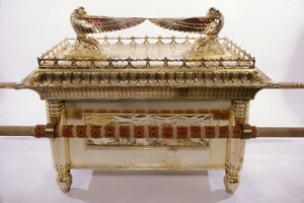
In Romans 3:21-8:39 Paul spends time teaching the Romans what a Christian is like, comparing the New Covenant with the Old, comparing Adam to Jesus, and illustrating how Heavenly Father is an active participant in our lives. The next few posts will deal with Romans 3:21-8:39. The following outline breaks down Romans 3:21-31:
Romans 3:21-31 The New Testament or Covenant
1. 3:21 The two witnesses to this covenant
2. 3:22-24 The absolute necessity of Jesus Christ
3. 3:25-26 How the New Covenant works in our lives
4. 3:27-28 The relationship of works to the New Covenant
5. 3:29-30 Who qualifies for the Atonement of Jesus Christ
6. 3:31 concluding statement
Propitiation – Romans 3:25
To be a propitiation – ἱλαστήριον hilastērion. This word occurs in another verse in the New Testament: Hebrews 9:5 – “and over it (the ark) the cherubim of glory shadowing the mercy-seat. It is used here to denote the lid or cover of the ark of the covenant. It was made of gold, and over it were the cherubim.
On the Day of Atonement in Old Testament times, the blood of a bullock offered was to be sprinkled “upon the mercy-seat,” and “before the mercy-seat,” “seven times,” (Leviticus 16:14-15). 1 This sprinkling or offering of blood was called making “an atonement for the holy place because of the uncleanness of the children of Israel,” (Leviticus 16:16). It was from this mercy-seat that the Lord forgave Israel, or expressed himself as reconciled (re-con-silio – to sit again with) to the house of Israel. The atonement was made, the blood was sprinkled, and the reconciliation was put into effect. The name was given to that cover of the ark, because it was the place from which Jehovah declared himself reconciled to his people.
Paul uses this word to emphasize the fact that Jesus Christ’s atonement brings us back into the presence of the Father. The Son performs the atonement, this propitiation, or merciful offering, that puts all of Heavenly Father’s children in a position whereby they can be brought back into his presence.
Justification – Romans 3:24-28
Here Paul teaches us how the gift of the Atonement of Jesus Christ operates in our lives. He states, “Being justified freely by his grace through the redemption that is in Christ Jesus… we conclude that a man is justified by faith without the deeds of the law (of Moses)” (Romans 3:24-28).
In its theological sense, justification is a forensic, or purely legal, term. It describes what God declares about the believer, not what He does to change the believer. In fact, justification effects no actual change whatsoever in the sinner’s nature or character. Justification is a divine judicial edict. It changes our status only, but it carries ramifications that guarantee other changes will follow. Forensic decrees like this are fairly common in everyday life.
Justification is more than simple pardon; pardon alone would still leave the sinner without merit before God. So when God justifies He imputes divine righteousness to the sinner (Romans 4:22-25). Christ’s own infinite merit thus becomes the ground on which the believer stands before God (Romans 5:19; 1 Corinthians 1:30; Philippians 3:9). So justification elevates the believer to a realm of full acceptance and divine privilege in Jesus Christ.
Elder D. Todd Christofferson put it this way:
Christ removes our condemnation without removing the law. We are pardoned and placed in a condition of righteousness with Him. We become, like Him, without sin. We are sustained and protected by the law, by justice. We are, in a word, justified. 2
How often does the Lord justify his children? All the time. In Doctrine and Covenants 31:4-5 the Lord tells Thomas B. Marsh, “You shall declare the things which have been revealed to my servant, Joseph Smith, Jun. You shall begin to preach from this time forth, yea, to reap in the field which is white already to be burned. Therefore, thrust in your sickle with all your soul, and your sins are forgiven you…”
In Doctrine and Covenants 62:3 speaking to the elders in the last days, the Lord said, “ye are blessed, for the testimony which ye have borne is recorded in heaven for the angels to look upon; and they rejoice over you, and your sins are forgiven you.”
In the Doctrine and Covenants 50:36 we read, “And behold, verily I say unto you, blessed are you who are now hearing these words of mine from the mouth of my servant, for your sins are forgiven you.”
Clearly there are many times in our lives when the Lord reaches out to justify us. For example, when we are testifying of him, listening to his servants, reaching out to help those in need, or serving his children, the atonement is operative in our lives – cleansing us from the sins of the world, changing us, improving our nature. While this sanctification process is long, justification – being made “just” is something God declares effective in the lives of humble saints often. Think of the ordinances of the gospel – for example, the sacrament. In this this ordinance we receive the grace of the Lord and with this, the power of his forgiveness. We become, because of the power of the atonement, justified. Elder Bruce R. McConkie put it this way:
Baptism is for the remission of sins; it is the ordinance, ordained of God, to cleanse a human soul. Baptism is in water and of the Spirit and is preceded by repentance. The actual cleansing of the soul comes when the Holy Ghost is received. The Holy Ghost is a sanctifier whose divine commission is to burn dross and evil out of a human soul as though by fire, thus giving rise to the expression baptism of fire, which is the baptism of the Spirit. Forgiveness is assured when the contrite soul receives the Holy Spirit, because the Spirit will not dwell in an unclean tabernacle.
The sacrament of the Lord’s Supper is the ordinance, ordained of God, in which baptized saints are privileged, repeatedly and often, to renew the covenant of baptism. Those who partake worthily of the sacramental emblems, by so doing, covenant on their part to remember the body of the Son of God who was crucified for them; to take upon them his name, as they did in the waters of baptism; and to “always remember him and keep his commandments which he has given them; that they may always have his Spirit to be with them.” (D&C 20:77.) Thus those who partake worthily of the sacrament—and the same repentance and contrition and desires for righteousness should precede the partaking of the sacrament as precede baptism—all such receive the companionship of the Holy Spirit. Because the Spirit will not dwell in an unclean tabernacle, they thus receive a remission of their sins through the sacramental ordinance. Through this ordinance the Lord puts a seal of approval upon them; they are renewed in spirit and become new creatures of the Holy Ghost, even as they did at baptism; they put off the old man of sin and put on Christ whose children they then are.
There are also numerous other sacred occasions when the saints may get in tune with and receive the sanctifying power of the Holy Spirit in their lives. The receipt of this heaven-sent boon always attests that the recipient has forsaken the world and is no longer encumbered by its wicked ways. One of these occasions may attend a proper anointing and blessing of the sick. “Is any sick among you?” James asks. “Let him call for the elders of the church; and let them pray over him, anointing him with oil in the name of the Lord: and the prayer of faith shall save the sick, and the Lord shall raise him up; and if he have committed sins, they shall be forgiven him. Confess your faults one to another, and pray one for another, that ye may be healed.” (James 5:14-16.) If the Spirit of the Lord rests upon one who is being blessed by the elders, in connection with this or any other ordinance, it automatically follows that the one blessed receives a remission of his sins; otherwise the Spirit would not be present. We do not want for occasions upon which sins may be remitted. Our problem is one of so living that we are worthy to have the companionship of the Spirit in our lives. 3
Notes:
1. Day of Atonement: The Day of Atonement was the 10th day of the 7th month. The directions for its observance are given in Lev. 16; 23:26–32; cf. Num. 29:7–11; Ex. 30:10. The day was kept as a national fast. The high priest, clothed in white linen, took a bullock as a sin offering and a ram as a burnt offering for himself and his house; and two he-goats as a sin offering and a ram as a burnt offering for the congregation of Israel. He presented the bullock and the two goats before the door of the tabernacle. He then cast lots upon the two goats. One was to be for the Lord for a sin offering. The other was for Azazel (the completely separate one, the evil spirit regarded as dwelling in the desert), to be sent away alive into the wilderness. He then killed the bullock, his own sin offering, and, taking a censer full of live coals from off the brazen altar with two handfuls of incense into the Holy of Holies, cast the incense on the coals there, so that the cloud of smoke might cover the mercy seat and, as it were, hide him from God. He then took of the blood of the bullock and sprinkled it once on the east part of the mercy seat (as an atonement for the priesthood), and seven times before the mercy seat (as an atonement for the Holy of Holies itself). Then he killed the goat, the congregation’s sin offering, and sprinkled its blood in the same manner, with corresponding objects. Similar sprinklings were made with the blood of both animals (bullock and goat) on the altar of incense (Lev. 16:15; Ex. 30:10) to make an atonement for the Holy Place. No one besides the high priest was allowed to be present in the tabernacle while these acts of atonement were going on. Lastly, an atonement was made for the altar of burnt offering in a similar manner. The goat for Azazel was then brought before the altar of burnt offering. Over it the high priest confessed all the sins of the people of Israel, after which it was sent by the hand of a man into the wilderness to bear away their iniquities into a solitary land. This ceremony signified the sending away of the sins of the people now expiated to the Evil One to convince him that they could no more be brought up in judgment against the people before God. Then the high priest took off his linen garments, bathed, put on his official garments, and offered the burnt offerings of two rams for himself and his people.
In Heb. 9:6–28 a contrast is drawn between the work of the high priest on the Day of Atonement, and the work of Christ, the great High Priest, who offered once for all the perfect sacrifice of himself. The sacrifices provided an annual “remembrance” of sin (Heb. 10:3–4), while the sacrifice of Christ removes the sin and leads to the complete sanctification of the believer (9:12, 14, 26; 10:10–18).
2. Elder D. Todd Christofferson, Justification and Sanctification, Ensign, June 2001, p. 18.
3. Elder Bruce R. McConkie, A New Witness for the Articles of Faith [Salt Lake City: Deseret Book Co., 1985], 239.



